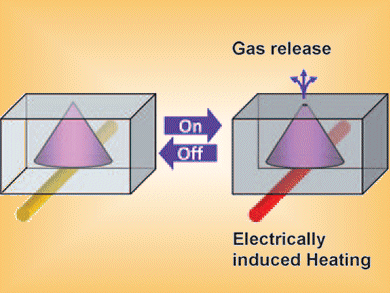Realistic Viewing Experience
3-D movies, Dolby surround for a more realistic audio experience—virtual reality is on the march. And how much more realistic would a film be if a barbecue actually smelled of grilled meat or if you could smell a sea breeze when the protagonist takes his love for an evening stroll on the beach? This type of smell experience may become reality for the home television viewer in the not-too-distant future. In the journal Angewandte Chemie, a team led by Jongmin Kim at Samsung Electronics in Korea and Sungho Jin at the University of California, San Diego, USA, have now introduced a new approach for making a compact device that could fit on the back of a television to produce thousands of different scents.
Previous technologies for the controlled release of scents were not simple enough and were much too crude for the sensitive electronics of our televisions and video players. An odor module needs to be small and robust and deliver results that are reproducible over multiple cycles; the response should be rapid and the user should be able to regulate the strength of the odor. Kim, Jin, and their co-workers aim to overcome these challenges with their new concept.
Scent-Containing Solutions
Their method is based on an array of individual cells that are filled with scent-containing solutions. The miniature containers are made from a cross-linked silicone polymer. Except for a tiny hole in the top, they are completely sealed. A needle can be used to inject a different scent solution into each cell. In the “off” state the tiny hole stays closed. The scent containers are switched on by heating. This causes the silicone to expand and the pressure on the inside to increase, forcing a small amount of gas-phase scent out of the tiny hole.
A two-dimensional lattice of heating wires, known as an X-Y matrix, can be used to specifically address individual containers. The scientists prepared a prototype, which they successfully tested with two different perfumes, “Live by Jenifer Lopez” and “Passion by Elizabeth Taylor”. Testers could detect both scents and differentiate between them.
“Our new concept is not only of interest for the entertainment industry,” state Kim and Jin, “it could also be used for combinatorial studies of gas-phase reactions and the development of vapor-based pharmaceuticals.”
Image: (c) Wiley-VCH
- An X–Y Addressable Matrix Odor-Releasing System Using an On–Off Switchable Device
H. Kim, J. Park, K. Noh, C. J. Gardner, S. D. Kong, J. Kim, S. Jin,
Angew. Chem. Int. Ed. 2011.
DOI: 10.1002/anie.201102759



